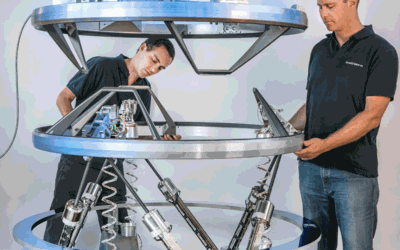Mon, Dec 11, 2017
Will Allow Soft Docking Of Small Spacecraft With ISS
The European Space Agency (ESA) has awarded a €26.6 million ($31.5 million) contract to QinetiQ to produce a new docking mechanism for the International Space Station (ISS).

Under the three-year deal, QinetiQ will qualify and produce the first flight model of its International Berthing and Docking Mechanism (IBDM), a prototype of which was developed under a previous ESA contract. QinetiQ and partners SENER and RUAG will invest an additional €7.1 million ($2.01 million) to take the technology from its prototype phase into full operation. The model produced under the new contract will be the first IBDM to fly to the ISS, pending placement of an order for its use in a specific docking mission.
The IBDM is designed to enable vehicles carrying cargo or passengers to dock softly with the space station by dissipating the kinetic energy on the approach. After minimizing the force of the initial impact, the mechanism makes the airtight connection between the two spacecraft.
The system is lighter and more versatile than competing designs, can accommodate large or small spacecraft, and is compatible with the newly agreed International Docking Standard, which seeks to allow docking between multiple types of spacecraft.
"BDM was first conceived as part of a NASA program over a decade ago, and we and ESA have continued to invest to make it a reality," said Erik Masure, Managing Director for Space, QinetiQ. "Existing designs require spacecraft to meet with a minimum amount of force, meaning the new generation of smaller vehicles must make a faster approach to connect. IBDM improves the safety and reliability of docking by enabling vehicles of all sizes to connect more slowly and with less force. Its compatibility with the International Docking Standard provides opportunities to export the technology internationally, laying a foundation for growth in QinetiQ’s space mechanisms business.”
Earlier this year, ESA announced that QinetiQ’s IBDM will be used on Sierra Nevada’s Dream Chaser spaceplane on its cargo missions, expected to take place from 2022.
(Image provided with QinetiQ news release)
More News
Aero Linx: International Association of Professional Gyroplane Training (IAPGT) We are an Association of people who fly, build or regulate Gyroplanes, who have a dream of a single >[...]
NORDO (No Radio) Aircraft that cannot or do not communicate by radio when radio communication is required are referred to as “NORDO.”>[...]
Beyond Visual Line Of Sight (BVLOS) The operation of a UAS beyond the visual capability of the flight crew members (i.e., remote pilot in command [RPIC], the person manipulating th>[...]
Aero Linx: Malibu M-Class Owners and Pilots Association (MMOPA) The Piper M-Class Owners & Pilots Association (PMOPA) is a not-for-profit organization dedicated to the interest>[...]
“After eight months of negotiating, and a failed TA, unfortunately management has not recognized the pilots’ needs. We have expressed to management that we are willing >[...]
 ANN's Daily Aero-Linx (05.29.24)
ANN's Daily Aero-Linx (05.29.24) ANN's Daily Aero-Term (05.29.24): NORDO (No Radio)
ANN's Daily Aero-Term (05.29.24): NORDO (No Radio) ANN's Daily Aero-Term (05.30.24): Beyond Visual Line Of Sight (BVLOS)
ANN's Daily Aero-Term (05.30.24): Beyond Visual Line Of Sight (BVLOS) ANN's Daily Aero-Linx (05.30.24)
ANN's Daily Aero-Linx (05.30.24) Aero-News: Quote of the Day (05.30.24)
Aero-News: Quote of the Day (05.30.24)



